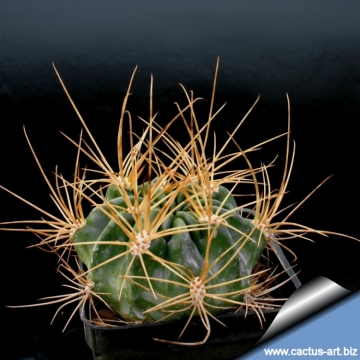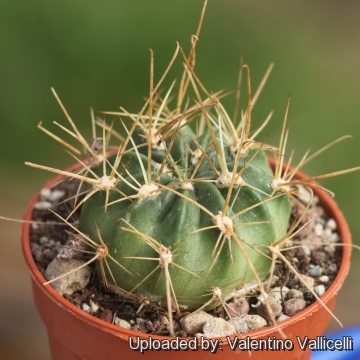Accepted Scientific Name: Echinopsis chrysochete Werderm.
Repert. Spec. Nov. Regni Veg. 39: 271. 1936 ( "chrysochele" )

Lobivia chrysochete (Echinopsis chrysochete) Photo by: Valentino Vallicelli
WR173 (Collector: Walter Rausch) Locality: Quebrada de Humahuaca, Jujuy, Argentina
Origin and Habitat: Echinopsis chrysocheteSN|21124]]SN|21124]] has a relatively wide range in Southern Bolivia (Chuquisaca and Tarija) and northern Argentina (Jujuy and Salta)
Altitude: 2400-4700 metres above sea level.
Habitat and Ecology: It grows in high-altitude grasslands (puna). There are no known threats to this species.
Note: The indigenous word "Puna" indicate the western region up to 4500 m that extends from the Peru, going throughout Bolivia to the Argentinian North. Delimited at west by a costal chain of high volcanic picks and by the Cordillera mountainous chain to the east. The Argentinian Puna is the natural continuation of the Bolivian highland.
Synonyms:
See all synonyms of Echinopsis chrysochete
back
Accepted name in llifle Database:Echinopsis chrysochete Werderm.Repert. Spec. Nov. Regni Veg. 39: 271. 1936 ( "chrysochele" )Synonymy: 10
back
Description: Lobivia chrysocheteSN|21125]]SN|21125]] is a very spiny cactus with a much flattened usually solitary body that attains a diameter of 25 cm (sometime forms small few branched clumps).
Root: This species has a shallow root system
Stems: Flattened globose to globose (but often taller and less flattened in cultivation) green, up to 25 cm broad and appears very like "Soehrensia".
Ribs: About 20, with chin shaped humps.
Central spines: 3 to 5 thin, 6-8 cm long, needle-like bristly, yellow to brownish.
Radial: Numerous (20-30) similar in colour to the central spines.
Flowers: 3-4 cm in diameter, widely funnelform, orange to red, shiny, with whitish centres.
Bibliography: Major references and further lectures
1) Walter Rausch “Lobivia: The Day Flowering Echinopsidinae from a Geographical Distribution Point of View” Vol. 1-3 R. Herzig, 1975
2) David Hunt, Nigel Taylor “The New Cactus Lexicon” DH Books, 2006
3) Edward F. Anderson “The Cactus Family” Timber Press, 2001
4) Lowry, M. 2013. Echinopsis chrysochete. In: IUCN 2013. IUCN Red List of Threatened Species. Version 2013.2. <www.iucnredlist.org>. Downloaded on 09 January 2014.
 Lobivia chrysochete (Echinopsis chrysochete) Photo by: Cactus Art
Lobivia chrysochete (Echinopsis chrysochete) Photo by: Cactus Art WR173 (Collector: Walter Rausch) Quebrada de Humahuaca, Jujuy, Argentina (Echinopsis chrysochete) Photo by: Valentino Vallicelli
WR173 (Collector: Walter Rausch) Quebrada de Humahuaca, Jujuy, Argentina (Echinopsis chrysochete) Photo by: Valentino VallicelliCultivation and Propagation: Echinopsis chrysocheteSN|21124]]SN|21124]] is an easy to grow succulent, more cold tolerant than most and less fussy regarding soil conditions.
Growth rate: It is a relatively rapidly growing and easily flowering species that will make smzsl clumps given the best conditions.
Soils: It likes very porous standard cactus mix soil.
Repotting: Use pot with good drainage.
Watering: Water regularly in summer, but do not overwater (Rot prone), keep dry in winter.
Fertilization: Feed with a high potassium fertilizer in summer.
Hardiness: Reputedly somewhat resistant to frost if kept on the dry side prior to, and during, cold weather (hardy to -12 C ° C, or less for short periods).
Exposition: Outside bright sunlight or afternoon shade, inside it needs bright light, and some direct sun. Tends to bronze in strong light, which encourages flowering and heavy spine production.
Uses: It is an excellent plant for container growing. It always looks good and stays small. It look fine in a cold greenhouse and frame or outdoor in a rockery.
Pests & diseases: It may be attractive to a variety of insects, but plants in good condition should be nearly pest-free, particularly if they are grown in a mineral potting-mix, with good exposure and ventilation. Nonetheless, there are several pests to watch for:
- Red spiders: they may be effectively rubbed up by misting the vulnerable plants every day.
- Mealy bugs: occasionally they develop aerial into the new growth among the wool with disfiguring results, but the worst types develop underground on the roots and are invisible except by their effects.
- Scales: they are rarely a problem.
It is wise to treat your whole collection with a systemic insecticide twice a year in spring and autumn.
- Rot: it is only a minor problem with cacti if the plants are watered and “aired” correctly. If they are not, fungicides won't help all that much.
Propagation: Division, direct sow after last frost. Seeds germinate in 7-14 days at 21-27° C in spring, remove gradually the glass cover as soon the plants will be well rooted (ca 1-2 weeks) and keep ventilated, no full sun for young plants! To make a cutting twist off a branch and permit it to dry out a couple of weeks, lay it on the soil and insert the stem end partially into the soil. Try to keep the cutting somewhat upright so that the roots are able to grow downward.












